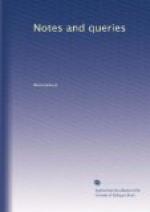Further, although Gascoigne was summoned to the first parliament on March 22, yet on its meeting on May 15, he was not present;—added to which, his usual position, as first named legal trier of petitions, was filled by Sir William Hankford, placed too in precedence of Sir William Thirning, the Chief Justice of the Common Pleas.
These facts, so contradictory to Dugdale’s date, rendered it necessary to refer to the roll. This, by the kindness of Mr. Duffus Hardy (who certainly can never be called the “streict-laced” gaoler of the records, alluded to in your fourth number, Vol. i., p. 60.), has been inspected; and the result is that the date of Hankford’s appointment, instead of being January 29, 1414, as stated by Dugdale, turns out to be March 29, 1413; just eight days after King Henry’s accession, and ten days previous to his coronation.
The peculiar period chosen for this act, and its precipitancy in contrast with the delay in issuing the new patents to the other judges, tend strongly, I am afraid, to deprive us of the “flattering unction” of supposing that it resulted from Gascoigne’s choice, rather than Henry’s mandate. Nor is the royal warrant of November 1414, 2 Henry V. (twenty months afterwards), granting him four bucks and four does yearly, during his life, out of the forest of Pontefract, a sufficient proof of favour to countervail the impression created by his early removal.
With these facts before us, King Henry’s supposed generosity in renominating Gascoigne can no longer be credited. But, even presuming that none of these facts had been discovered, I must own myself surprised that any one could maintain that Gascoigne was ever Chief Justice to Hen. V., with two existing records before him, both containing conclusive proof to the contrary.
The first is the entry on the Issue Roll of July, 1413, of a payment made of an arrear of Gascoigne’s salary and pension, in which he is called “late Chief Justice of the Bench of Lord Henry, father of the present King.”
The second is the inscription on his monument in Harwood Church in Yorkshire, where he is described as “nuper capit. justio. de banco Hen. nuper regis angliae quarti.”
I think I may fairly ask whether it is possible to suppose that in either of these records, particularly {163} the latter, he would have been docked his title, had he ever been Chief Justice of the reigning king?
Allow me to take this opportunity of thanking L.B.L. for his extracts from the Hospitaller’s Survey (Vol. ii., p. 123.), which are most interesting, and, to use a modern word, very suggestive.
Edward Foss.
Street-End House, near Canterbury.
* * * * *
AN OLD GUY?




